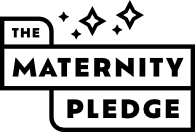FAQs.
How does The Maternity Pledge work?
The Maternity Pledge provides support for the transition into motherhood, otherwise known as matrescence. We do this through our workplace pledge and unique Matrescence Packs.
You can sign the pledge here and we’ll send you your digital badge, your Maternity Pledge Handbook and templates over email and your Matrescence Packs in the post.
I’m interested in our company joining The Maternity Pledge but we don’t currently do everything on the pillars
Our Maternity Pledge Handbook and resources that accompany it will enable you to meet those pillars for your next employee that goes on maternity leave. You don’t have to be doing it already to join the pledge, but by signing up you are committing to the pledge in the future.
My company isn’t in the pledge can I buy a Matrescence pack?
Matrescence Packs will be available to buy in 2024 if your employer isn’t part of The Maternity Pledge.
Who are the Matrescence Packs for?
These packs are for anyone who has a new baby, through birth, adoption or surrogacy. This can be first, second or even third or fourth baby. The packs aren’t just for first time mothers.
What’s in it for the dads?
The Matrescence packs are helpful to fathers who will all experience Patrescence, the process of becoming a father. Although not as transformational as matrescence, this changing role can sometimes be a struggle for dads as they find it hard to form a connection with their baby and adapt to the changing dynamic and environment of the household. By reading the Matrescence Packs, the father will have a better understanding of matrescence and how they can support early motherhood and therefore feel part of the family and build a better connection with their child.
Dad's in a same sex relationship, may not find the pledge and contents of the Matrescence Pack relevant to their experience of early parenthood.
Why is the pledge only focused on maternity leave rather than paternity leave?
We are focusing on maternity leave because research shows
60% of women leave their job after returning to the workplace
How employees are treated on maternity leave has a significant impact on retaining that member of staff
Three years after a baby is born 90% of father are in full time work compared to 28% of mothers.
Our aim with the Maternity Pledge is to help keep mothers in the workplace if they want to be and through that we hope to see more women in leadership roles.
Are there any plans to provide The Maternity Pledge to expectant mothers who are self employed or aren’t in employment?
Yes, this will be launching in 2024.
What is the Matrescence Club?
This is a weekly email for new mothers to help them maintain their identity in motherhood. Firmly routed in humour, kindness and honesty, it's an extension to the magazine to help mothers navigate their matrescence.
You can sign up here.
A note on our language.
There is debate in maternity care on whether words that reference the female sex should be replaced. A recent study from ‘Frontiers in Global Women’s Health’ has indicated that there are risks to desexing language. “Avoiding “women” and “mothers” can decrease inclusivity by requiring use of technical, more difficult to understand language. For example, when “women” is replaced with “people with a cervix”, this aids misunderstanding, particularly for those with low literacy or learning difficulties, or who are non-English speakers. Alternative terms for “women” that refer to reproductive body parts or processes such as “uterus havers”, “birthers” or “menstruators” are recognised as dehumanising and so to be avoided…Thoughtful, careful discussion and consideration on this subject is needed.”
The Maternity Pledge has made the decision to use ‘mother’ and ‘motherhood’ as inclusive terms. In 2019 UK law determined “Being a mother, is the status given to the person who undergoes the physical and biological process of being pregnant, carrying and giving birth to a child.” At The Maternity Pledge we extend that language to include those who adopt or go through surrogacy as well.
